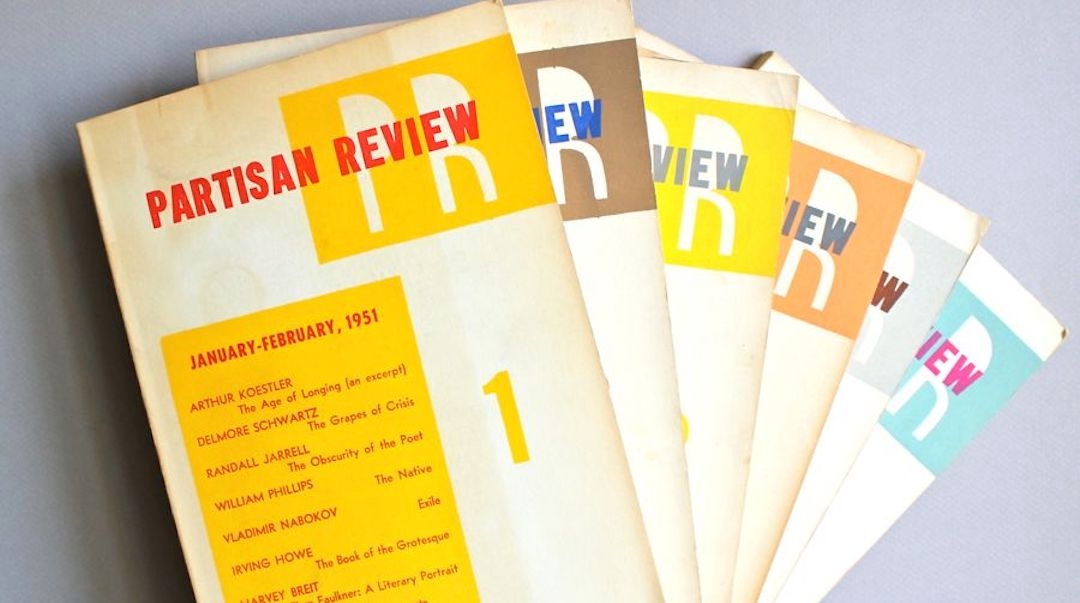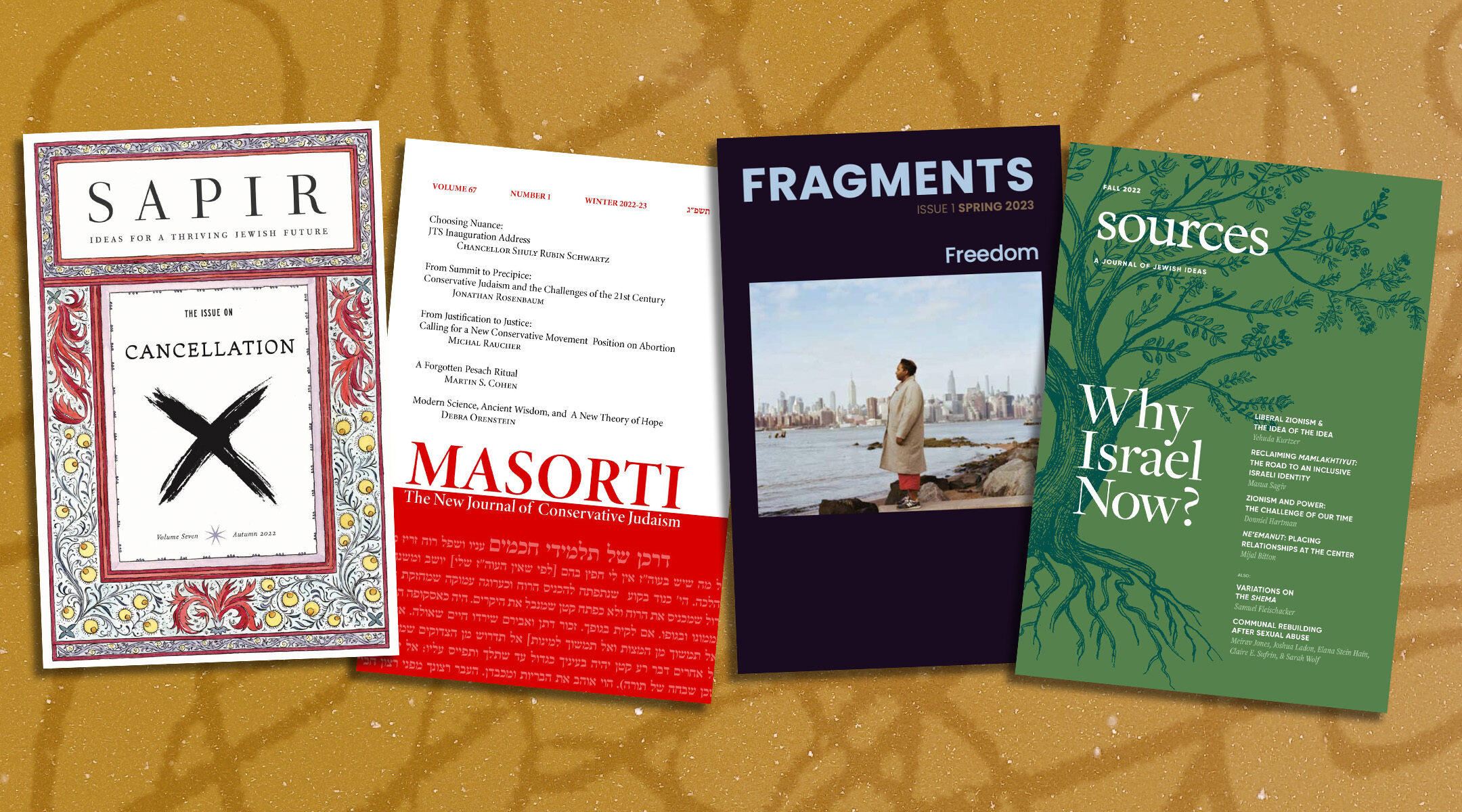(JTA) — The last 20 years haven’t been kind to Jewish journalism, with local weeklies shrinking or folding and even big city papers suspending their print publications and going completely digital. Publishing online has allowed these papers to cut costs and given them the potential for a wide reach — albeit a potential undermined by an increasingly siloed and ideologically polarized market for news and ideas.
Yet still there are those who aren’t giving up on print — at least in small, carefully targeted batches. This spring has seen the launch of two Jewish journals — Masorti, a reboot of the former Conservative Judaism, and Fragments, a product of the left-leaning Jewish human rights group T’ruah. The two magazines join a small but scrappy fraternity of journals aiming to steer the Jewish conversation.
“We’re the people of the book. I think print is having a moment,” said Rabbi Lev Meirowitz Nelson, who as director of Emor, T’ruah’s affiliated think tank, edits Fragments. “In the midst of all the [digital] bombardment people experience, there’s something very grounding about picking up a hard copy and being able to mark it up or carry it with you.”
Of course, Fragments and its more established cousins — from a legacy Modern Orthodox quarterly like Tradition to the interdisciplinary journal Modern Judaism — are all available online, and few print more than 1,000 copies at a time. The goal, the editors and publishers of some of the newer publications told me, is to establish a brand and repair what each one said was a broken communal discussion about Israel, domestic politics and religion.
“I hate what’s become of discourse in Jewish life, which largely goes on on Twitter and other places like that,” said Mark Charendoff. “I think Jews like longform discussions, and we’ve become very, very impatient. I wanted to carve out a space for that long type of writing and reading.”
Charendoff is president of the Maimonides Fund, which publishes Sapir, perhaps the best known of the newish journals. It has a high-profile editor — Bret Stephens, the conservative columnist on the New York Times opinion page — and a penchant for hot-button topics that rally conservatives and enrage liberals. Recent issues of the two-year-old journal have focused on “cancel culture” and a campus environment that most of its contributors consider hostile to conservatism and Jewish life.
“I think society and the Jewish community has become so polarized that people are afraid of articulating controversial views. We need to take a breath and say, ‘You’re not going to be harmed by reading something you disagree with,’” said Charendoff.
T’ruah believes there are plenty of controversial views being aired, but mostly on the right: It has explicitly positioned its new journal as a “necessary alternative to well-funded right-wing Jewish publications.” The news release announcing Fragments did not name those publications but presumably they include Sapir; Mosaic, supported by the right-leaning Tikvah Fund; and Tablet, which is published by Nextbook, Inc., whose president, Mem Bernstein, is on the board of Tikvah and is the widow of its founder. Tablet has published writers from across the political spectrum, but has drawn howls from the left for its frequent articles denouncing “wokeness” and cancel culture and a recent piece questioning the motives of donors who support gender-affirming care for trans people.
(Another journal, The Jewish Review of Books, was initially backed by Tikvah, but recently spun off under its own foundation.)
The premiere issue of Fragments includes essays on concepts of freedom by Laynie Soloman, a director at SVARA, an LGBTQ yeshiva based in Chicago, and Joelle Novey, the director of an interfaith environmental group in the Washington, D.C. area.
Nelson sees two audiences for Fragments: “It’s definitely speaking to the left and offering a deepening of language and of conversation around Jewish sources and Jewish ideas,” he said. “And it’s an effort to speak to the center, which often shares our values and can be spooked by the language they see coming from the right.”
Fittingly for a magazine published by a group formerly known as Rabbis for Human Rights, Fragments leans into Jewish text and religious perspectives. That sets it apart from Jewish Currents, a legacy journal of the Jewish left that, after a relaunch in 2018, now aims for an audience of young, left-wing, mostly secular Jews who, when not anti-Zionist, are deeply critical of Israel. Arielle Angel, editor in chief of Jewish Currents, has said that the magazine has become “a reliable and essential space for challenging, rigorous, surprising work that has shifted the discourse even beyond the American Jewish left.”
The aspiration that the “discourse can be shifted” by gladiators writing for small magazines harkens back to the post-World War II period, a sort of golden age of Jewish thought journals. Jewish and Jewish-adjacent publications like the Menorah Journal, Partisan Review, Commentary and Dissent provided a launching pad for an ideologically fluid cohort of “New York intellectuals” that over the years included Sidney Hook, Hannah Arendt, Lionel Trilling, Saul Bellow, Irving Howe, Delmore Schwartz, Norman Podhoretz, Paul Goodman, Midge Dector, Jeanne Kirkpatrick and Alfred Kazin.

Partisan Review was among a spate of magazines that offered a platform for Jewish intellectuals in the years immediately after World War II. (Open Culture)
While writers like these tackled Jewish issues, or general issues through a Jewish lens, many of them influenced the wider national conversation. Angel has said she has drawn inspiration from Commentary: Founded in 1945 by the American Jewish Committee, the magazine became hugely influential in promoting neoconservative ideas and thinkers in the 1980s and ’90s.
The “golden age” was an explosion of Jewish creativity, and political influence, that would be difficult to replicate today. Benjamin Balint, a former editor at Commentary and author of a history of the magazine, says the flowering of Jewish journals in the mid-20th century was the result of “terrific pent-up pressure among the children of immigrants who were pushed down for so long and were able to explode into the mainstream.” Small magazines “provided that release — pushing critics and writers into the larger culture,” said Balint, who previously edited Sources, the journal of the Shalom Hartman Institute of North America.
A long piece in Tablet recently argued that such Jewish influence is in steep decline “anywhere where American Jews once made their mark,” from academia to Hollywood to government. Author Jacob Savage doesn’t blame the loss of the immigrant work ethic, however, but rather “American liberalism” for marginalizing Jews.
Whatever the cause, few of the newer journals aspire to that kind of influence on the larger culture, and acknowledge that they are trying to shape the conversation within the Jewish community.
“We believe that Jewish leaders need great ideas to do their work well,” said Rabbi Justus Baird, senior vice president for national programs at the Shalom Hartman Institute of North America and publisher of its journal Sources, launched in 2021. “The way we invest in ideas is by cultivating a large group of Jewish thinkers and scholars who are doing not just the scholarship for its own sake, but really trying to work collaboratively on how Jewish thought can apply to the challenges facing the Jewish people.”
The Hartman Institute (which also counts the Maimonides Fund among its long list of major donors) is a religiously pluralistic, liberal Zionist think tank with outposts in New York and Jerusalem. Recent essays in Sources include lengthy essays by Yale religious studies professor Christine Hayes on the ethics of shaming and Hartman scholar Mijal Bitton on how relationships can heal the breach between the Diaspora and Israel.
Part of Hartman’s goal in publishing the journal is to provide a space for such long-form articles, filling what Baird calls “a gap between the quick, super-responsive, news-oriented Jewish publication landscape, the hot takes about what is going on, and the academic Jewish work.”
“It’s a space where ideas can really percolate,” said Claire Sufrin, who now edits Sources. “The written word, the printed word is there and can be shared in that way and people can engage with it over and over again.”
Masorti, the relaunched journal of Conservative Judaism, is also trying to bridge a gap, in this case between Jewish scholarship and the synagogue.
“Rabbis have responsibilities to serve as congregational leaders, and also the obligation to engage in Jewish learning and scholarship,” said Rabbi Joseph Prouser, the editor of Masorti.
The original Conservative Judaism was published from 1945 through 2014. The reboot is sponsored by the movement’s Rabbinical Assembly and its five seminaries, including the Jewish Theological Seminary, the New York flagship. Its readership base is rabbis and cantors affiliated with the movement.
Masorti arrives at a critical time for the Conservative movement: In an essay in the first issue, its associate editor, Rabbi Jonathan Rosenbaum, says what was once America’s largest Jewish denomination is at a “precipice.”
“At its summit, the plurality of [North American] Jews identified with the Conservative movement, something like 40%,” Rosenbaum said in an interview. “There was something like 1.6 million Jews who were thought to be part of the Conservative movement up to maybe the late ‘80s, early ‘90s. Today, there are about 500,000.
“Part of the goal of the journal,” he said, is to “look at the problems and the means of solving them.”
In the past the Conservative Judaism journal had been a forum for debate within the movement. It published dueling papers, for example, on the decision to ordain women and what is and isn’t permissible on Shabbat. Prouser says he’ll uphold that tradition of dissent: The current issue features an essay by Michal Raucher, a Jewish studies professor at Rutgers University, who criticizes the movement’s establishment for embracing a justification for abortion that doesn’t go far enough in recognizing the bodily autonomy of women (an argument she also advanced in a JTA oped).
And Prouser does hope these arguments are heard beyond the movement, positioned between traditionalist Orthodoxy and liberal Reform. “One of the beauties of the Conservative movement is that we can talk to people to our right to our left right, we can talk to the entire spectrum of the Jewish community,” he said.
The editors of the new journals agree that there are fewer and fewer spaces for civil conversation among Jews, blaming the filter bubble of the internet and the take-no-prisoners style of current political debate. And each said they would like to be part of the solution.
Sufrin, the editor of Hartman’s journal, calls it a “bridge, because people can talk about it together, they can engage with the ideas together, and it’s in that conversation that they can develop a relationship and ultimately, talk together more productively.”
The question is whether it is too late: At a time when algorithms reward readers with the kind of material they are likely to agree with, will even an elite reach across ideological divides and listen to what the other side is saying? When institutions — from government to religion — regard compromise as surrender, who dares to concede that your ideological opponent might have a point?
“Difference and disagreement are productive when we engage with the best versions of those with whom we disagree,” Hayes writes in Sources. That sounds like a call to action. Or is it an epitaph?
JTA has documented Jewish history in real-time for over a century. Keep our journalism strong by joining us in supporting independent, award-winning reporting.






